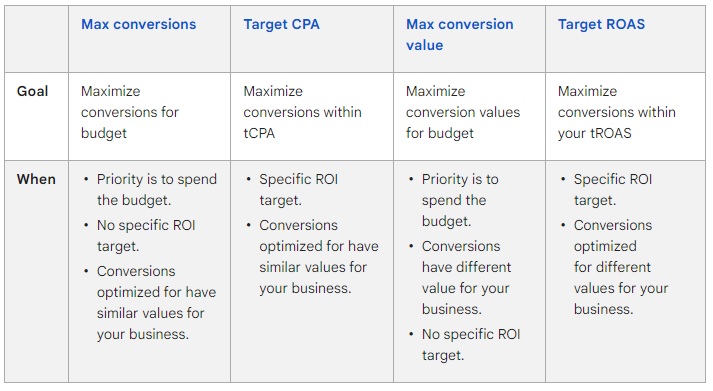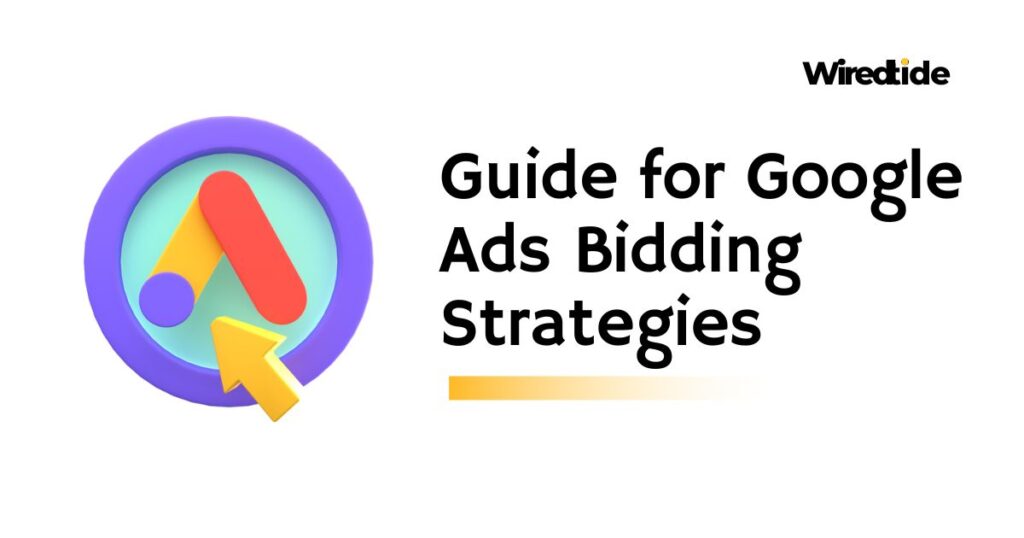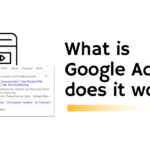Google Ads offers a variety of bidding strategies that help advertisers achieve their specific campaign goals, whether it’s driving good website traffic, increasing sales, or maximizing return on investment (ROI).
Choosing the right bidding strategy is key to the success of your Google Ads campaigns.
This guide will walk you through the different Google Ads bidding strategies, explaining how each one works and when to use them.
Understanding Bidding Strategies in Google Ads
Bidding strategies in Google Ads determine how you pay for users to interact with your ads. The choice of strategy depends on your specific goals, such as getting clicks, impressions, or conversions.
Google Ads offers two main types of bidding strategies:
- Manual Bidding: You set bids manually for each keyword or ad group
- Automated Bidding: Google Ads automatically adjusts your bids based on various signals to maximize the desired outcome.
Manual CPC (Cost-Per-Click) Bidding
Manual CPC bidding gives you complete control over your maximum CPC bids, allowing you to set bids at the ad group or keyword level. This strategy is ideal if you want to manage your bids manually and have granular control over your spending.
Here we need to note down key considerations. Manual CPC requires constant monitoring and adjustments to optimize performance.
Automated Bidding Strategies
Google Ads offers several automated bidding strategies that use machine learning to optimize bids in real-time. Here are the key automated strategies.

1. Maximize Clicks
Maximize Clicks is an automated bid strategy that sets your bids to get as many clicks as possible within your budget. This strategy is ideal for driving traffic to your website.
- Maximize Clicks automatically sets your bids to get as many clicks as possible within your budget.
- Best strategy where primary goal is to increase website traffic and Brand awareness campaigns.
- Easy to set up and manage, maximizes click volume.
- Doesn’t focus on Conversions or ROI, which might lead to irrelevant traffic.
2. Maximize Conversion
Maximize Conversion is an automated bidding strategy that aims to get the most conversion value within your budget. Unlike Target ROAS, it doesn’t set a specific return on ad spend target but focuses on maximizing total conversion value.
- Maximize Conversions automatically sets bids to help you get the most conversions for your budget.
- Businesses looking to maximize revenue.
- E-commerce campaigns with varied product values.
- Simple setup, maximizes the number of conversions.
- Requires accurate tracking of conversions.
- Can lead to higher costs per conversion if not monitored closely.
3. Target Impression Share
Target Impression Share bid aims to show your ad on a specific percentage of eligible impressions. You can choose to target absolute top of the page, top of the page, or anywhere on the page.
- Brand awareness campaigns where visibility is more important than conversions.
- Guarantees a certain level of visibility
- May result in higher costs with less focus on clicks or conversions.
4. Enhanced CPC (ECPC)
Enhanced CPC is an automated bid strategy that adjusts your manual bids to help you get more conversions while trying to maintain your same cost-per-conversion. Google automatically increases or decreases your manual bids based on the likelihood of a conversion.
- Good for advertisers who prefer manual bidding but want some automation to boost conversions.
- Campaigns with conversion tracking enabled.
- eCPC can increase bids up to 30% more than your manual bids, so it’s important to monitor the impact on your budget.
5. CPM (Cost-Per-Thousand Impressions)
CPM bidding charges you for every 1,000 impressions your ad receives. This strategy is commonly used in Display and Video campaigns.
- Ideal for brand awareness campaigns where the goal is to reach a broad audience.
- Effective for broad reach and brand visibility.
- Doesn’t optimize for clicks or conversions, focusing more on impressions.
6. vCPM (Viewable Cost-Per-Thousand Impressions)
Viewable CPM (Cost-Per-Thousand Impressions) is a manual bidding strategy for display ads where you pay for impressions that are actually viewable by users. This is ideal for increasing brand awareness.
- Display campaigns focused on visibility.
- Brand awareness campaigns.
- Focuses on visibility rather than clicks or conversions.
- Suitable for display campaigns with high impression goals.
- Higher cost compared to traditional CPM bidding.
7. CPV (Cost-Per-View)
CPV bidding is used in video campaigns, where you pay for each view of your video ad. A view is counted when a user watches 30 seconds (or the full video if it’s shorter) or interacts with your video.
- Video marketing campaigns.
- Brand awareness via video content.
- Works best with engaging video content.
- You pay only when someone views or interacts with the video.
Choosing the Right Bidding Strategy
When it comes to running successful digital advertising campaigns, choosing the right bidding strategy can make all the difference. Whether you’re new to the game or a seasoned pro, understanding how to select a strategy that aligns with your goals is crucial for maximizing your ROI. Let’s break down how to choose the best bidding strategy for your needs in a simple and effective way.
1. Understand Your Goals
The first step in choosing the right bidding strategy is to clearly define what you want to achieve. Are you looking to increase website traffic, generate leads, or boost sales? Your objectives will guide your bidding strategy selection.
For instance, if your goal is to drive traffic, a cost-per-click (CPC) strategy might be ideal. On the other hand, if you’re aiming for conversions, a cost-per-acquisition (CPA) strategy could be more effective.
2. Know Your Budget
Your budget plays a significant role in determining which bidding strategy to use. Different strategies have different cost structures, so it’s essential to understand how much you’re willing to spend. If you have a limited budget, you might want to start with manual CPC bidding to control costs more closely. With larger budgets, automated strategies like Target CPA or Target ROAS (Return on Ad Spend) can help optimize your spending and improve performance.
3. Evaluate Your Competition
Knowing what your competitors are doing can give you valuable insights. Research their strategies and see how aggressive their bidding is. This information can help you decide whether you need to bid higher to stay competitive or if a more conservative approach might work better for your specific market.
4. Consider Your Ad Platform
Different advertising platforms offer various bidding options, so it’s important to choose a strategy that aligns with the platform you’re using. For example, Google Ads offers several bidding strategies, including CPC, CPA, and Maximize Conversions.
Each has its own set of advantages and is suited to different types of campaigns. Make sure to review the platform’s options and select the one that best fits your campaign goals and budget.
Test and Adjust
No matter which bidding strategy you start with, it’s essential to monitor your results and make adjustments as needed. Digital advertising is dynamic, and what works well today might not be as effective tomorrow. Regularly review your campaign performance, test different strategies, and adjust your approach based on what’s working best.
Remember, digital advertising is an ongoing process of testing and optimization, so stay flexible and keep refining your strategy for the best results.
Quick Tips to Selecting a Strategy
- New Campaign with a Small Budget: Start with Manual CPC or Maximize Clicks.
- Focus on Conversions: Use Target CPA or Maximize Conversions.
- Revenue Focused: Choose Target ROAS or Maximize Conversion Value.
- Brand Awareness: Use Target Impression Share or vCPM.
How to Set Up Bidding Strategies in Google Ads
To set up a bidding strategy in Google Ads:
Step 1: Log in to your Google Ads account and navigate to the campaign you want to edit.
Step 2: Go to the “Settings” tab within your campaign.
Step 3: Under the “Bidding” section, select “Change bid strategy.”
Step 4: Choose your desired bidding strategy from the list.
Step 5: Adjust additional settings like target CPA, ROAS, or maximum CPC if applicable.
Step 6: Save your changes.
Best Practices for Optimizing Bidding Strategies
- Keep an eye on key metrics like CPC, CPA, and conversion rates to ensure your strategy is working. (Monitor Performance Regularly)
- Use data-driven insights to tweak your bidding strategy as needed.(Adjust Based on Data)
- Test different strategies to find the best-performing one for your campaigns.(Use A/B Testing)
- Align your bidding strategy with achievable targets based on your budget and historical performance. (Make Sure Goal should be Realistic ).
Mistakes to Avoid When Choosing a Bidding Strategy
Selecting the right google ad bidding strategy can be tricky, and making mistakes along the way can cost you both time and money.
Here are some common pitfalls to watch out for when choosing a bidding strategy for your digital advertising campaigns:
1. Ignoring Your Goals
One of the biggest mistakes is not aligning your bidding strategy with your campaign goals. If you’re aiming for brand awareness, but you’re using a strategy focused on conversions, you might miss the mark. Always start by defining what you want to achieve whether it’s increased traffic, more leads, or higher sales and choose a bidding strategy that matches those objectives.
2. Overlooking Budget Constraints
It’s easy to get excited about the potential of different bidding strategies, but overlooking your budget can lead to overspending. If you choose a strategy that’s too aggressive for your budget, you could quickly deplete your funds without seeing the desired results.
Make sure your chosen strategy fits within your financial limits and adjust accordingly if needed.
3. Neglecting to Research Competition
Failing to research your competitors can leave you at a disadvantage. Understanding how your competitors bid and what strategies they use can provide valuable insights.
If you’re not aware of their tactics, you might end up bidding too high or too low, impacting your campaign’s effectiveness. Take some time to analyze your competition and adjust your strategy based on this information.
4. Relying Solely on Automated Strategies
Automated bidding strategies can be incredibly useful, but relying on them exclusively without monitoring and adjusting can be a mistake. Automated systems use algorithms to optimize your bids, but they may not always align perfectly with your specific goals or market changes.
Regularly review your campaign performance and make manual adjustments if necessary to ensure optimal results.
5. Ignoring Performance Data
Another common mistake is neglecting to monitor and analyze your campaign performance data. Choosing a bidding strategy isn’t a set-it-and-forget-it situation. Continuously track how your strategy is performing against your goals and make data-driven adjustments. Ignoring performance metrics can lead to wasted budget and missed opportunities.
6. Failing to Test Different Strategies
Assuming one bidding strategy will work perfectly for all campaigns can be a costly mistake. What works for one campaign or audience may not work for another. Testing different bidding strategies on a smaller scale can help you determine what’s most effective for your specific needs. Be open to experimenting and refining your approach based on the results.
7. Not Considering Seasonality and Trends
Market trends and seasonality can impact the effectiveness of your value based bidding strategy. For instance, during peak seasons or sales events, competition might increase, requiring adjustments to your bidding approach.
Failing to account for these factors can lead to suboptimal performance. Stay aware of industry trends and adjust your strategy accordingly to stay competitive.
Conclusion
Choosing the right Google Ads bidding strategy is key to achieving your marketing goals efficiently. Whether you opt for manual control with Manual CPC or leverage Google’s automation with strategies like Target CPA or Maximize Conversions. the right approach can significantly impact your campaign’s success. Regularly reviewing your strategy and adapting to performance data will ensure that your campaigns remain competitive and cost-effective.
Remember: The digital advertising landscape is dynamic, so what works today may need adjustments tomorrow. Stay informed, test different strategies, and continuously optimize to stay ahead.




